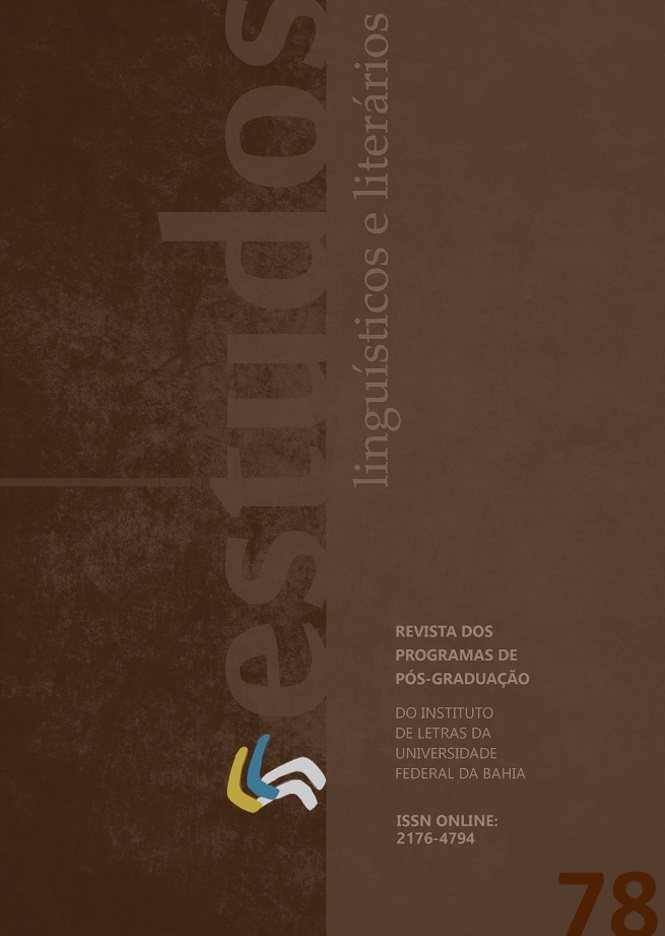DEICITY AND MORPHOSYNTAX OF DEMONSTRATIVES IN KIMBUNDU:
ANALYSIS OF THE GRAMMAR OF DIAS AND CHATELEAIN
DOI:
https://doi.org/10.9771/ell.v0i78.59633Keywords:
Demonstratives; Kimbundu; Bantu; African linguistics.Abstract
In this study, I analyze the interpretations of demonstratives in two Kimbundu grammars Dias (1667); and Chatelain (1889). I assume Lyons (1999), Diessel (1999), Guardiano (2009) e Levinson (2018) to describe semantic, pragmatic, and morphosyntactic properties of demonstratives. I assumed that the two grammars would have similar descriptions, but I identified divergences in the quantity and oppositions of demonstratives. These divergences can be explained mainly by extralinguistic factors, such as the perception or importance of the phenomenon; the development of printing techniques, grammatical characterization, and the evolution of scientific studies; and the purpose of producing grammars. Intralinguistic factors, such as linguistic change and variation, are not conclusive.
Downloads
References
ALENCASTRO, L. F. de. Os africanos e as falas africanas no Brasil. In: GALVES, C.; GARMES, H.; RIBEIRO, F. R. (orgs.). África-Brasil: caminhos da língua portuguesa. Campinas: Editora da Unicamp, p. 15-25. 2009.
ANGENOT, J.; KEMPF, C. B.; KUKANDA, V. Arte da Língua de Angola de Pedro Dias (1697) sob o prisma da Dialetologia Kimbundu. Papia, n. 21, v. 2, 2011, p. 231-252.
BOSTOEN, K.; de VELDE. M. V. Introduction. In: de VELDE. M. V. The Bantu Languages. 2. ed. Londres/ New York: Routledge, 2019.
CHATELAIN, H. Grammatica Elementar do Kimbundu ou Língua de Angola. Genebra: Typographia de Charles Schuchardt. 1888-1889.
DIAS, Pedro, S.J. Arte da lingva de Angola,/ oeferecida [sic]/ a Virgem Senhora N. do/ Rosario, Mãy, & Senhora dos mesmos/ Pretos. Lisboa: Officina de Miguel Deslandes,Impressor de Sua Magestade. Anno 1697.
DIESSEL, H. Demonstratives: form, function, and grammaticalization. Philadelphia: Amstedam, 1999.
DIESSEL, H. Demonstratives, joint attention, and the emergence of grammar. Cognitive Linguistics, n. 17, v. 4, p. 463-489, 2006.
DIESSEL, H. Distance contrasts in demonstratives. In: DRYER, M. S.; HASPELMATH, M. (orgs.). The world atlas of language structures online. Leipzig: Max Planck Institute for Evolutionary Anthropology, 2013.
DRYER, M. S.; HASPELMATH, M (eds.). WALS Online (v2020.3), Zenodo, 2013. Acessado em: 22 de abril de 2024. Disponível em: https://doi.org/10.5281/zenodo.7385533
FERNANDES, G. Primeiras descrições das línguas africanas em língua portuguesa. Confluência. n. 49, p. 43-67, 2015.
FIORIN, J. L.; PETTER, M. África no Brasil: a formação da língua portuguesa. São Paulo: Contexto. 2008.
GUARDIANO, C. The syntax of demonstratives: A parametric analysis. Comunicação apresentada no 19th Colloquium on Generative Grammar, 2009, Vitoria-Gasteiz.
GUTHRIE, M. Comparative Bantu: An Introduction to the Comparative Linguistics and Prehistory of the Bantu Languages. Volume 2: Bantu Prehistory, Inventory and Indexes. London: Gregg International. 1971.
HAMMARSTRÖM, H. An inventory of Bantu languages. In: de VELDE. M. V. (org.). The Bantu Languages. 2. ed. Londres/New York: Routledge, 2019.
HEIM, I. Definiteness and indefiniteness. In: von HEUSINGER, K.; MAIENBORN, C.; PORTNER; P. (orgs.). Semantics: An international Handbook of Natural Language Meaning. v. 2, Berlim: De Gruyter, 2011, p. 1025-1058.
IONIN, T.; KO, H.; WEXLER, K. Article Semantics in L2 Acquisition: The Role of Specificity. Language Acquisition, v. 12, n. 1, p. 3-69, 2004.
LEVINSON, S. C. Introduction: demonstratives: patterns in diversity. IN: LEVINSON, S. C. et al. (orgs.). Demonstratives in Cross-Linguistic Perspective. Cambridge: Cambridge University Press, 2018. p. 1-42.
LYONS, C.. Definiteness. Cambridge: Cambridge University Press, 1999.
MAHO, J. F. A Classification of the Bantu Languages: An Update of Guthrie’s Referential System. In: NURSE, D.; PHILIPPSON, G. (orgs.). The Bantu Languages. London; New York: Routledge, 2003. p. 639-651.
MEIRA, S.; GUIRATDELLO-DAMIAN, R.. Brazilian Portuguese: Non-contrastive exophoric use of demonstratives in the spoken language. IN: LEVINSON, S. C. et al. (orgs.). Demonstratives in Cross-Linguistic Perspective. Cambridge: Cambridge University Press. 2018. p. 116-33.
NEGRÃO, E. V.; VIOTTI, E. Brazilian Portuguese as a transatlantic language: Agents of linguistic contact. InterDISCIPLINARY Journal of Portuguese Diaspora Studies, v. 3, n. 1, 2014. p. 135-154.
NGUNGA, A. Introdução à linguística Bantu. Maputu: Imprensa Universitária, 2004.
PARANHOS, R. A.; FIGUEIREDO, C. Os Demonstrativos e os sistemas de situacionalidade na comunidade rural afro-brasileira de Helvécia. In: FIGUEIREDO, C. et al. (orgs.). Língua em movimento. Salvador: Edufba, 2020. p. 103-127.
PEREIRA, H. B. “Esse” versus “este” no Português Brasileiro e no Europeu. 2005. 109f. Dissertação (Mestrado em Filologia e Língua Portuguesa) – Universidade de São Paulo, São Paulo.
PETTER, M.; ARAUJO, P. P. Linguística Africanas: passado e presente. PETTER, M. (org.). Introdução à Linguística Africana. São Paulo: Contexto, 2015.
PHILIPPSON, G.; GROLLEMUND, R. Classifying Bantu languages. In: De VELDE. M. V. The Bantu Languages. 2. ed. Londres/New York: Routledge, 2019.
ROSA, M. C. Pera saberem pronunciar o que acharem escrito: ler quimbundo, língua estrangeira, no século XVII. 20115. 173f. Tese (Progressão docente para a Classe E, denominada Professor Titular) - Rio de Janeiro: Universidade Federal do Rio de Janeiro.
ROSA, M. C. O quimbundo em cinco testemunhos gramaticais. Confluência, n. 56, p. 55-113, 2019.
De VELDE, M. Nominal Morfology and syntax. In: De VELDE. M. V. (org.). The Bantu Languages. 2. ed. Londres/New York: Routledge, 2019.


